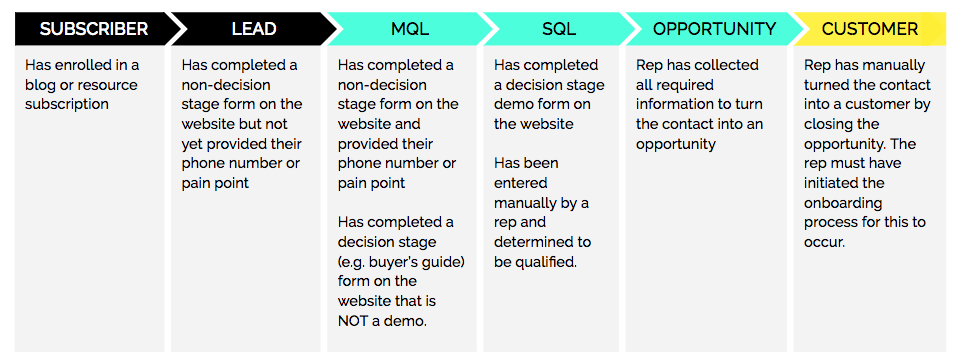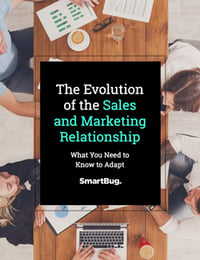
Handing Leads Off to Sales & the Marketing Qualified Lead (MQL) vs. Sales Qualified Lead (SQL) Difference
February 20, 2023
By Jesse Snyder
How do you know when a lead is ready to be handed off to sales? What's the difference between a marketing qualified lead (MQL) and sales qualified lead (SQL)?
An MQL is a contact that is sales-ready but is not yet ready for direct, personal attention from sales. An SQL is ready for direct sales follow-up, and one-on-one engagement should be a priority. However, the exact definitions of MQL versus SQL vary based on your customer lifecycle and are defined by marketing and sales.
As you think about the difference between a MQL and a SQL, you should also think about your customer lifecycle, which may be similar to what is illustrated in the graphic below.

Defining marketing qualified leads (MQL) and sales qualified leads (SQL) for your organization must be done through a partnership between sales and marketing. Making sure everyone understands the difference between MQLs and SQLs is the foundation of the lead handoff process.
The Importance of the MQL-to-SQL Process
As a teenager, I ran track and became familiar with the art of passing the baton. Although my teammates and I didn’t go on to run in the Olympics, I still have the blue ribbons that prove we weren’t entirely terrible athletes. Being fast was essential to winning any sprint event on the track, but with relays, how you executed the handoff could make the difference between first place and disqualification.
Perfecting the baton handoff required careful timing, trust in your teammates, and effective communication. When we finally figured out the perfect order in the handoff sequence, my high school relay team went from personal best times to surpassing school records.
Handing leads from marketing to sales is quite similar to the baton handoff. And just like my teammates and I had to prepare and make adjustments in order to beat records, you'll have to prepare and make adjustments in order to find the right time to hand a lead off from marketing to sales.
Create an SLA
While you define each stage of your customer’s lifecycle and the handoff process between marketing and sales, you’ll need a place to document these definitions. This is where a service-level agreement (SLA) comes into play. An SLA for marketing and sales documents goals and what each team plans to contribute to those goals. It should also document the definitions of MQL and SQL and the procedures for handling those leads. In short, it should contain everything you need to execute an effective handoff.
Critical Considerations for MQL and SQL Definitions
As you consider your definitions for MQLs and SQLs, as well as the best time to hand a lead off from marketing to sales, here are some key considerations to keep in mind:
Lead Behavior
One of the most critical factors for differentiating a lead from an MQL or SQL is their behavior on your website or how they engage with your company. The weight that a particular action or piece of demographic information carries within lead scoring or routing rules will depend on your company. For example, Company A may notice that first-time visitors are as likely to purchase as a repeat visitor, while Company B’s leads aren’t expected to convert until they’ve visited the site three or more times. No matter how much weight you place on particular behaviors, these are some general characteristics to monitor and consider factoring into your MQL and SQL definitions:
- First-time visitor versus repeat visitor
- Conversion count or the number of times they fill out a form
- Stage in the buying cycle as indicated by the content they consume (e.g., visiting a pricing page)
- Channel or source (e.g., are leads from LinkedIn more likely to become customers?)
- Don’t forget negative attributes like competitors or job applicants
Lead Demographics
If you have a lead that fits an ideal customer profile and is easily identifiable in form submissions or third-party data insights, like Datanyze, you may want to pass the contact to your sales team for a quick follow-up. Information such as company size or industry are common B2B examples, but pain points or a persona can also be great ways to qualify a lead as an MQL or SQL.
Lead Scoring
Lead scoring is a way to combine various attributes and behaviors to provide perceived value to each lead. It can help organizations prioritize leads or define them as an MQL or SQL based on a ranked score. For most organizations, however, lead scoring requires maintenance that outweighs the value it provides. Before you implement lead scoring as part of your handoff process, consider whether you need it or if it would be possible to qualify leads through simple routing rules rather than lead scoring. Here are two critical criteria to determine whether it’s time to implement lead scoring:
- Sufficient data: Demographic and behavior data are essential for creating lead scoring values. Not just any lead data works; most companies need a vast amount of meaningful customer data to determine weights and measures for lead scoring.
- Reps drowning in leads: If your reps aren’t complaining about how long it takes to manually evaluate too many leads, you likely aren’t at a point where lead scoring makes sense.
Streamline the MQL-to-SQL Process and HandOff
Once you’ve defined MQL and SQL definitions, you know who to hand off, but you still need to agree on how to pass leads to sales. A lead scoring automation tool can help determine the overall engagement of a lead in order to understand how well your marketing and sales activities are working to hold the lead’s interest. Automation through your CRM should allow you to quickly distribute new SQLs via a notification email or task along with relevant information. To ensure the smoothest possible transition, discuss with your team what information needs to be passed along and what the follow-up will look like based on lead intelligence and behavior.
Discuss and Adapt
On a weekly or monthly basis, marketing and sales should meet to discuss any leads that were passed and whether or not the process needs to be adjusted. As your business and buyers change, your handoff processes will inevitably need to be adjusted.
Although your marketing and sales teams may not be working toward a record on the track, you are working toward revenue growth. Getting there requires a smooth passing of leads from marketing to sales as they move through the funnel. If you do it right, you’ll hit your targets; if you drop the baton in the handoff, you might get disqualified.
This post was originally published in January 2014 and has been updated since.

About the author
Jesse Snyder was formerly a strategic-thinking, passionate, results-driven digital and traditional Marketing Specialist at SmartBug. He loves learning new things and working on innovative projects with collaborative teams that will push his skills and abilities further. Throughout his career Jesse has worked on integrated campaigns across all verticals - both paid and organic - and has a diverse skillset from managing to owning the end-to-end creative process. His professional experience is in the following sectors: manufacturing, telecommunications, and jewelry. Read more articles by Jesse Snyder.








![Sales-Enablement-Playbook-[Template]-cover](https://www.smartbugmedia.com/hs-fs/hubfs/Sales%20Enablement%20Playbook.png?width=200&height=260&name=Sales%20Enablement%20Playbook.png)



